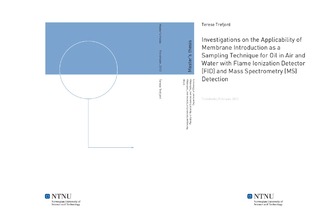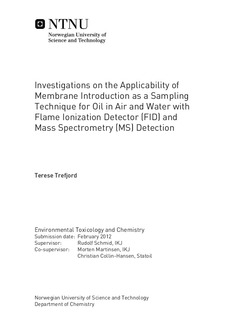| dc.contributor.advisor | Schmid, Rudolf | nb_NO |
| dc.contributor.advisor | Martinsen, Morten | nb_NO |
| dc.contributor.advisor | Collin-Hansen, Christian | nb_NO |
| dc.contributor.author | Trefjord, Terese | nb_NO |
| dc.date.accessioned | 2014-12-19T13:21:25Z | |
| dc.date.available | 2014-12-19T13:21:25Z | |
| dc.date.created | 2012-04-20 | nb_NO |
| dc.date.issued | 2012 | nb_NO |
| dc.identifier | 517117 | nb_NO |
| dc.identifier | ntnudaim:6527 | nb_NO |
| dc.identifier.uri | http://hdl.handle.net/11250/247698 | |
| dc.description.abstract | During a membrane introduction (MI) analysis the analytes are separated from the bulk matrix (e.g. air or water) by a semi-permeable membrane and transported to the detector by a carrier gas (usually helium). The most commonly used detector for MI-analyses is the mass spectrometer, resulting in membrane introduction mass spectrometry (MIMS). The main advantages of MIMS are short response times, high sensitivity, simplicity and elimination of sample preparation and pre-separation. Membrane introduction analyses are suitable for detection of volatile organic compounds (VOCs) and semi volatile organic compounds (SVOCs). In this project the applicability of MIMS and membrane introduction flame ionization detector (MIFID) for oil analyses were tested. Investigations of 12 different oil samples from light crude oils to heavy oils were performed by MIFID and MIMS for both water and air (only two oil samples were analyzed by water MIMS). For the oil in air analyses good response were achieved, and information about response times and half-times could be obtained within a reasonable period of time. The water analyses however showed some limitations. Even after long analysis times (up to 1200 minutes) useful information on response time were rarely obtained, and no half-times for depletion could be measured. Pre-equilibration of the oil samples seems to be necessary to enable reasonably fast MI analyses of water samples (approximately) equilibrated with the oil, allowing an estimation of oil concentrations in water. For the MIMS analyses spectral information are obtained, providing an indication of the content of the oil samples, as well as information about how the abundance of different ions change throughout the analyses due to weathering.Best results were obtained by the lighter oil samples, due to higher amounts of compounds favorable for MI-detection. Analysis times obtained were slightly shorter for MIFID analyses, as compared to MIMS analyses. | nb_NO |
| dc.language | eng | nb_NO |
| dc.publisher | Institutt for kjemi | nb_NO |
| dc.subject | ntnudaim:6527 | no_NO |
| dc.subject | MSENVITOX Environmental Toxicology and Chemistry | no_NO |
| dc.subject | Environmental Chemistry | no_NO |
| dc.title | Investigations on the Applicability of Membrane Introduction as a Sampling Technique for Oil in Air and Water with Flame Ionization Detector (FID) and Mass Spectrometry (MS) Detection | nb_NO |
| dc.type | Master thesis | nb_NO |
| dc.source.pagenumber | 158 | nb_NO |
| dc.contributor.department | Norges teknisk-naturvitenskapelige universitet, Fakultet for naturvitenskap og teknologi, Institutt for kjemi | nb_NO |

